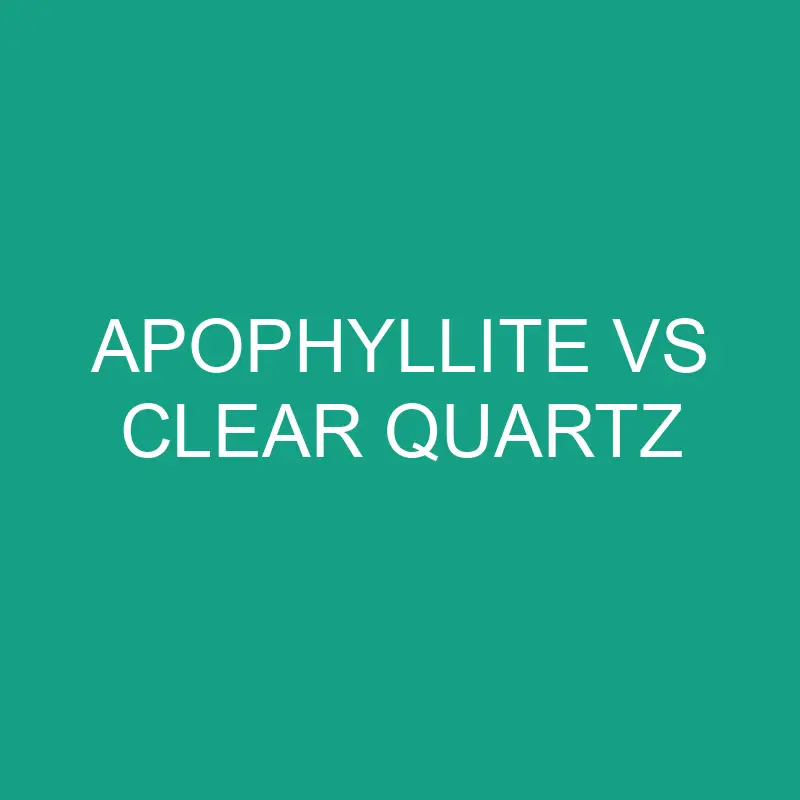Apophyllite and clear quartz are both fascinating minerals, each with its own distinct characteristics, uses, and metaphysical properties. Let’s explore the differences between Apophyllite and Clear Quartz.
Post Contents
Apophyllite:
Origins and Geology:
- Origins: Apophyllite is a mineral belonging to the phyllosilicate group. It is typically found in basalt cavities and is commonly associated with zeolite minerals. Significant deposits are found in India, Brazil, Iceland, and the United States.
Physical Properties:
- Color: It is usually colorless, white, or light green. It can be transparent to translucent.
- Crystal Structure: Apophyllite crystals often form in square or pyramidal shapes, and they are usually prismatic.
- Luster: Apophyllite crystals have a vitreous to pearly luster.
Uses:
- Metaphysical: Apophyllite is believed to enhance intuition, connect one to higher realms, and facilitate spiritual awakening.
- Healing Practices: It is used in crystal healing for its purported ability to aid respiratory issues and allergies.
Clear Quartz:
Origins and Geology:
- Origins: Clear Quartz, often referred to as rock crystal, is one of the most abundant minerals on Earth. It can be found in various locations globally, with notable deposits in Brazil, Madagascar, the United States, and the Swiss Alps.
Physical Properties:
- Color: Clear Quartz is colorless and transparent. However, it can also occur in various shades due to impurities.
- Crystal Structure: Quartz crystals have a hexagonal structure and often form six-sided prisms with pointed terminations.
- Luster: Clear Quartz has a vitreous luster and is known for its clarity and brilliance.
Uses:
- Jewelry: Clear Quartz is widely used in jewelry, cut into various shapes for pendants, earrings, and rings.
- Technology: It is a key component in electronic devices due to its piezoelectric properties.
- Metaphysical: Clear Quartz is considered a powerful amplifier of energy, enhancing spiritual growth, and promoting clarity of thought.
Comparison: Apophyllite vs. Clear Quartz
Color and Transparency:
- Apophyllite: Usually colorless, white, or light green. Can be transparent to translucent.
- Clear Quartz: Colorless and transparent, known for its clarity.
Crystal Structure:
- Apophyllite: Forms prismatic crystals, often in square or pyramidal shapes.
- Clear Quartz: Has a hexagonal crystal structure, forming six-sided prisms with pointed terminations.
Luster:
- Apophyllite: Vitreous to pearly luster.
- Clear Quartz: Vitreous luster, known for its brilliance and clarity.
Metaphysical Properties:
- Apophyllite: Associated with spiritual awakening, intuition, and connection to higher realms. Used in crystal healing for respiratory issues.
- Clear Quartz: Considered a powerful amplifier of energy, promoting spiritual growth, and enhancing mental clarity.
Common Uses:
- Apophyllite: Often used in metaphysical practices, crystal healing, and as a collector’s mineral.
- Clear Quartz: Widely used in jewelry, electronics, and metaphysical practices. It is one of the most versatile and commonly used crystals.
Availability:
- Apophyllite: Less abundant compared to clear quartz and is often associated with zeolite deposits.
- Clear Quartz: Abundant and found in various locations worldwide.
Conclusion: Choosing Between Apophyllite and Clear Quartz
Both Apophyllite and Clear Quartz are stunning minerals with unique qualities. Apophyllite is often sought after for its spiritual and metaphysical properties, particularly its connection to higher realms. On the other hand, Clear Quartz, with its unparalleled clarity and versatility, is widely used in jewelry and has a long history of being regarded as a powerful amplifier of energy.
When choosing between Apophyllite and Clear Quartz, it ultimately depends on your specific preferences and the intended use. If you are drawn to spiritual and metaphysical properties, Apophyllite may be a preferred choice. For those looking for a classic and versatile crystal with a myriad of applications, Clear Quartz is an excellent option. Whether for personal adornment, spiritual practices, or scientific applications, both minerals contribute to the rich tapestry of Earth’s treasures.
